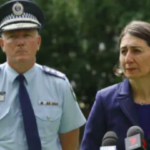Sydney Siege – How Was It Allowed to Happen?

The Sydney Siege has raised more questions than it has answered.
If Man Haron Monis had survived Monday’s heinous crime, the charges he could have faced may have included detain for advantage, kidnapping, weapons charges, terrorism, murder – and the list goes on.
And of course, he was already facing over 40 sexual assault charges, as well as being an accessory to his former wife’s murder.
Let’s not forget that she had been mercilessly subjected to a brutal murder in 2013 – stabbed and set alight.
As the allegations against Monis hit the media spotlight once again during the siege, many questions emerged.
One of the most circulated questions was: how could he be released on bail for so many serious offences whilst already serving two good behaviour bonds and a community service order?
Another question might be: how did police and ASIO, with their increasingly extensive powers, let someone like Monis slip under the radar?
And how on earth did he get his hands on a rifle/shotgun and manage to carry it into the middle of the Sydney CBD?
Even Tony Abbott admits that systems should have been in place to monitor Monis.
The event is likely to be dissected and analysed for years to come.
And it will almost certainly provide impetus for even greater state powers – despite the fact that ASIO was apparently not using them in respect of this man.
Monis wasn’t even on the ‘terrorism watch list’ – despite being well-known for his public hatred of US and Australian foreign policy.
He had been disowned by the mainstream Muslim community for years due to his unacceptable views and disgraceful actions.
He lost his High Court appeal just days before the siege – failing in his bid to get his convictions overturned.
Those convictions were for sending “grossly offensive” letters to the families of Australian soldiers who were killed in Afghanistan.
And after his appeal was knocked back, he reportedly posted on his social media page that he would “fight the oppression and terrorism of USA and its allies including UK and Australia.”
How could these events not have been seen as a red flag by ASIO, with it’s extensive powers to monitor internet and social media?
Let’s look at the situation:
Monis was already convicted of sending offensive letters to the families of fallen Australian soldiers.
He then lost his appeal.
He then posted threats on social media.
How could he, of all people, not have been monitored?
In relation to bail, newspapers have reported that the local court Magistrate had no choice but to release Monis for the accessory to murder charges, as the case against him and his partner, Amirah Droudis, was “weak”.
Commentators have widely criticised the former bail act for causing the release of dangerous people into the community.
But it seems that those voices are missing the point here: the fact is that, given the events preceding the siege, police and the DPP could have made an application to revoke Monis’ bail on the basis that he had become an ‘unacceptable risk’ to the community.
Alternatively, they could have applied for a Preventative Detention Order (‘PDO’) to keep him in custody, even if he had not technically committed a crime.
1. Revoking Bail
Did you know that an application to revoke bail can be made by prosecutors (police or DPP) at any time?
Monis’ fresh threats on social media in the context of losing his appeal may well have led to the revocation of bail on the basis that he had become an ‘unacceptable risk’ to the community.
Yet neither police nor the DPP made an application to revoke Monis’ bail.
Applications for revocation of bail are common, and they can be listed urgently if there is a pressing situation.
Yet some people are blaming magistrates and judges, when they are simply dealing with what has been brought before them.
An application for revocation of bail was not brought before them at any stage, despite the new bail act having been in force since 20 May 2014.
Some have even blamed Monis’ lawyer, which is extraordinary considering that he was merely doing his job.
A lawyer does not have the duty or responsibility, let alone the power, to monitor their clients or anyone else.
Nor can they apply to revoke their own client’s bail, unless they are instructed to do so.
And it is fundamental to the operation of our criminal justice system that:
a) even ‘undesirable’ people are allowed to have legal representation, and
b) lawyers do their best for their clients – in fact, it is a criminal defence lawyer’s duty to do so.
Imagine the criticism (and formal complaint) that a defence lawyer would face if, like some have suggested, he or she didn’t do his job properly and purposely lost a bail application for a client!
2. Preventative Detention Order
PDOs have been in place since 2002 as part of the NSW Terrorism (Police Powers) Act.
They allow police to detain people without even charging them with a crime.
Under normal circumstances, police cannot keep a person in custody without charge for more than a few hours.
But with a PDO, police can hold a person for up to 14 days.
PDOs are not often used because they represent a huge infringement on personal liberty and the presumption of innocence – yet they are certainly available.
Some of the first people to be detained under PDOs were those suspected of participating in terrorist plots in September this year.
All of those detained under PDOs were eventually released without charge.
In order to get a PDO, police must have a “reasonable suspicion” that the person going to engage in an imminent terrorist act.
PDOs can also be used in some circumstances after an attack has occurred.
Given the events leading up to the siege, police could certainly have applied for a PDO to keep Monis in custody.
And how about the firearm?
There is the residual question of how Monis obtained the rifle/shotgun used in the siege.
To muddy the waters, there have been conflicting reports about whether he held a firearms licence at the time.
The consensus seems to be that he didn’t.
But if he did, why didn’t police seize any gun/s in his possession and apply to revoke the licence?
Given the serious charges against Monis, any such application would almost certainly have been granted.
If he didn’t have a licence, how did he get his hands on a gun?
And why wasn’t he being more closely monitored?
————————–
At the end of the day, it is entirely unfair to blame the presiding magistrate or Monis’ lawyer for the fact that he was out on bail and able to commit his vile act.
If anything, the question should be: why weren’t law enforcement and prosecuting bodies doing their jobs by:
a) applying to revoke bail,
b) applying for a PDO, and/or
c) using their immense powers to monitor this man more closely.
————————-
Despite all that has been said above, one must admit that hindsight is always 20:20.
And even if Monis had been monitored or under a PDO, he may still have been able to do the same sort of thing in the not-too-distant future.
It’s easy to dissect, analyse, criticise and blame.
But the powers were certainly there to potentially put this man into custody, and criticism of the magistrate and lawyers is unfair and unfounded.
Whatever the case, nothing can detract from the fact that responsibility for the tragic killing of two innocent people, and the indescribable pain and torment now being suffered by their families, lies squarely with Man Haron Monis.






